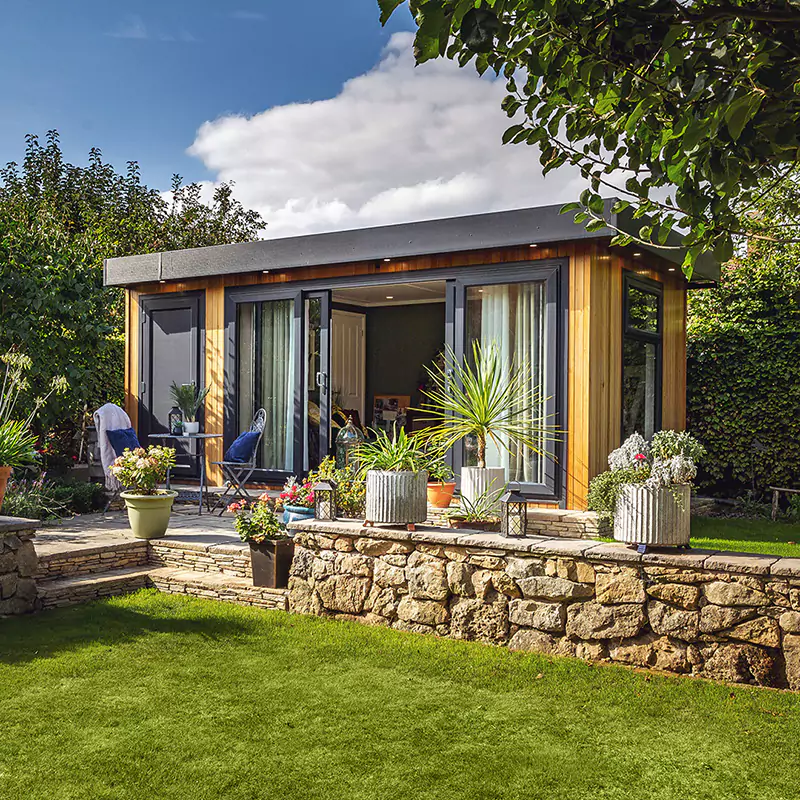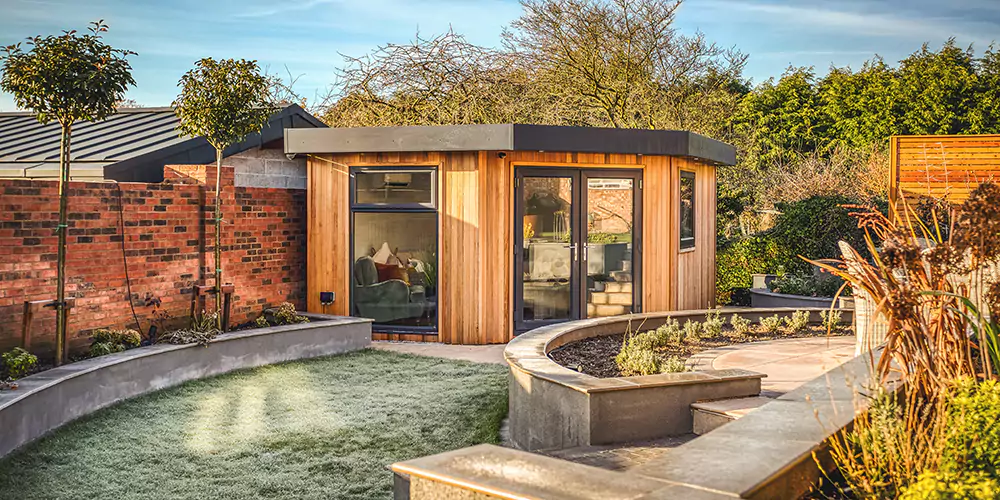Free News For Planning Permission For Garden Offices
Free News For Planning Permission For Garden Offices
Blog Article
How Big Can A Garden Room Be?
Size restrictions on specific areas will usually determine whether planning permission is required for garden rooms, extensions, conservatories outhouses. Here's a summary of the common size-related criteria that might require you to apply for permission to plan: Total Area Coverage:
Planning permission will be required for detached outbuildings in excess of 50% of the total space surrounding the house (excluding its footprint).
Height Restrictions
Single-story structures The maximum eaves height must not exceed 2.5 meters. The overall height shouldn't exceed 4 meters in the case of an eaves-pitched roof, or 3 meters in the case of any other type of roof.
Constructions that are within 2 meters from the property's boundary: Maximum Height is 2.5 meters.
Floor Area:
The building code could be required for structures that are that are larger than 30 square meters even though planning permission isn't required.
Proximity with boundaries
If the building is less than 2 meters away from the border, a permit for planning is required when the building's height is greater than 2.5 metres.
Building Usage
The size of garden rooms is not the only thing to consider but their purpose can influence whether planning permission is required. If, for instance, the structure is intended be used as a place to stay for residents or manage a small-scale business, then planning permission will likely be required.
Permitted Development Rights:
Permitted Development Rights are governed by certain conditions and limits on size. These rights may vary depending on whether the property is within a conservation area.
Conservatories & Extensions
For single-story rear extensions, the maximum depth of an extension is typically 4 meters for detached homes, and 3 metres for terraced or semidetached homes. They can be raised to 8 meters or 6 meters under the Neighbourly Consultation Scheme if certain conditions are met.
The rear extension of a single-story building must not be higher than 4 meters.
Side Extensions
The maximum height of a side extension must not exceed 4 meters.
Volume Restrictions
In some areas (such as conservation areas and Areas of Outstanding Natural Beauty) A building which increases the house's volume by more than 10 percent or 50 cubic metres (whichever is larger) could require planning permission.
Front Extensions
Extensions that extend past the front of the house facing the street will usually require planning permission.
Contact your local authorities because the rules could differ depending on local councils and conditions on the property. Building regulations approval might be required even if the planning permission is not required. This could be for structural integrity or safety reasons. View the top rated garden work pod for blog recommendations including conservatories and garden rooms, 4m x 4m garden room, luxury outhouse, outhouse buildings, outhouse building, ground screws vs concrete base, garden buildings , garden rooms, garden room, what size garden room without planning permission and more.
What Is The Environmental Impact Of The Garden Rooms, Etc.?
Be aware of the impact on the environment when constructing the garden room outhouse, conservatory, or garden offices can determine the need for approval for planning. Here are the key environmental factors to consider: Biodiversity and Wildlife:
If the proposed construction would affect wildlife habitats within the area, for example hedgerows, trees and ponds, you'll require permission to plan the project. An ecological survey may be needed to assess and reduce the impact on biodiversity.
Habitats, Species and Environment:
If the site is home to species that are protected (e.g. bats, newts, etc.)) or within or near protected habitats (e.g., Sites of Special Scientific Interest : SSSI) the planning permission is vital. In order to protect them, it is necessary to adopt particular measures.
Preservation Orders for Trees Preservation Orders
A permit to plan is required for any proposed construction that involves the removal or alteration trees protected by TPOs. The local authority can ask for replacement plantings as well as alternative mitigation measures.
Flood Risk and Water Management
In the case of developments that are located in areas with high risk of flooding or in close proximity to water bodies, approval for planning is required. A assessment of flood risk (FRA) could be required to ensure that the building doesn't increase the risk of flooding and is equipped with drainage solutions.
Sustainability in construction:
To ensure that sustainable materials and construction techniques are employed, planning permission may be required. This includes considerations for energy efficiency, insulation, and the carbon footprint of the building materials.
Drainage of surface water runoff
It is important to consider the impact on the environment that comes with any construction project. Planning permission will ensure that appropriate drainage structures are in place to prevent waterlogging or flooding.
Soil and Land Stability
This can include potential issues such as soil erosion or subsidence, especially in sloped areas. It includes issues such as subsidence and soil erosion on sloped areas.
Air Quality
If you are planning to develop a project that could affect the quality of air in the local area like those in close proximity to industrial areas or major roads, planning permission is needed. The pollution levels in the air should be within acceptable levels and mitigation measures must be in place.
Noise Pollution:
Planning permission is required if you intend to use the extension to your garden or the room in a way that will generate significant sound (e.g. an instrument or workshop). The local authority must evaluate noise levels and potential impacts on neighbours and the environment.
Waste Management:
The disposal of waste during construction and afterward is crucial. The planning permission permits adequate waste disposal, recycling and minimizing environmental impact.
Energy Efficiency
Planning permission may be accompanied by the need for energy efficient technology like solar panels or high-performance glazing. This will help reduce the carbon footprint.
Conformity to Environmental Regulations:
Environmental laws and regulations are applicable to all developments which includes the UK Environmental Protection Act. Planning approval ensures that all standards are met, in addition to the development being sustainable for the environment.
In the end, planning permission for garden rooms, conservatories, outhouses, gardens offices or extensions should consider a wide spectrum of environmental impact. Consult the local planning authority as early as you can in the planning phase to make sure you are aware of the particular requirements. Read the best armoured cable depth regulations uk for site info including garden buildings , garden office hertfordshire, garden rooms near me, best heater for log cabin, garden office electrics, garden rooms near me, conservatories and garden rooms, insulated garden rooms, herts garden rooms, garden rooms near me and more.
Concerning The Location Restrictions, What Kind Of Planning Permission Are You Required To Build Gardens?
The location of garden rooms or conservatories, along with outhouses, office buildings and garden offices can be a major factor in determining whether planning permission is needed. These are the most important elements to take into consideration when choosing a location The proximity of boundaries
A structure that is located within 2 meters from the boundary of a property is not allowed to exceed 2.5 meters in height. If the height exceeds this limit, planning permission is required.
Front of the property
Buildings or extensions that are constructed in front of the principal elevation of a house (the face-facing side) usually require planning permission. This is due to the fact that allowed development rights usually don't permit them.
The Property's Side:
Side extensions must be in line with particular height and size limitations and usually require permission for planning if they extend beyond the existing side wall of the house.
The rear of the property
Size and height restrictions are applicable to rear extensions, including gardens. The planning permission must be obtained if the extensions exceed permitted growth limits.
Designated Areas
More stringent controls are in place for conservation zones, Areas of Outstanding Natural Beauty, National Parks and World Heritage Sites. Every new building regardless of its size may require planning permission.
List of Listed Buildings
The properties that are listed as listed have more strict rules. Planning permission as well as listed-building consent are required in order to construct the new structure or to alter an existing one, no matter the location within the property.
Green Belt Land:
The construction of green belts is prohibited in order to safeguard open spaces. It is common to require special permissions to construct a new structure or significant alteration.
Flood-prone areas:
If the building is located in a flood risk zone further regulations are required to ensure the new structure isn't a source of increased flooding risk. Planning permission, and perhaps an assessment of risk for flooding might be required.
Urban vs. Rural settings
Urban and rural areas are usually governed in different ways. Rural properties may be more relaxed about restrictions, such as the size or placement of outbuildings.
Highways and Public Rights of Way
The structure could require planning permission to ensure that it doesn't block views, access or safety if it is close to highways, roads or other public rights-of-way.
Shared Ownership Land or Leasehold Land
If you have a property that is leasehold or part in a shared ownership plan, it is possible to seek additional permission from the property owner or the managing entity. You may also need planning permission depending on the local laws.
Nearby to other structures:
The building may require planning permission to avoid negative effects on adjacent land or buildings.
To get advice on the specifics of your property's situation and location, it's best to contact the local planning authority. Local laws could have a major impact on the rules. It is important to follow all regulations to avoid legal issues or fines. View the top rated cinema garden room for blog info including herts garden rooms, costco outhouse, costco garden room, do you need planning permission for a garden room, garden rooms in St Albans, garden rooms near me, herts garden rooms, how to lay decking on soil, outhouse builders, ground screws vs concrete and more.